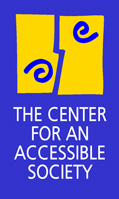
DISABILITY
ISSUES
INFORMATION
FOR JOURNALISTS
ABOUT
THE CENTER
Wed, 20 Nov 2002 -- Media Matters No. 19:
Writing an op-ed, part 3An op-ed is often selected by editors on the basis of whose byline it carries. Whose name can go on your op-ed? Your director's? Your board president's? Some celebrity who has devoted time and money to your organization's cause? The person "signing" the op-ed should be someone who will have credibility with the media. The name of a known expert -- or, in today's star-struck society, a celebrity -- on the op-ed will go a long way toward getting it considered seriously, especially at national media outlets.
Most media-savvy organizations have at least one staff person (some have an entire department!) devoted to media relations. These staffers, who also produce news releases and press kit materials, are often the "ghostwriters" on op-eds. But it's not their name that goes onto the op-ed; it's someone in the organization, or connected to the organization, whose name will likely carry some weight with a newspaper's op-ed editor.
Of course, this ghostwriter can't just put a person's name onto the op-ed without permission. But it goes beyond getting permission. The person whose name will appear in the byline of the op-ed may not have written the piece, but she/he does need in some way to "own" it. This means that beyond granting permission for her name to be used, she must at a minimum read the piece, understand and agree with its points, and be aware that an op-ed editor may contact her to verify that she is the "author." While op-ed editors know (and expect) that the submissions they receive may not have literally been written by the person whose byline it carries (Pres. Bush doesn't write his own speeches, either), they want to ensure that the person "owns" the material being submitted.
The person whose byline the piece carries may have suggestions for editing the piece as well. And it's also wise to run the draft by someone in your organization who's not familiar with the issue, to be sure the piece makes sense and is compelling to the average reader who's not involved with the issue, either.
An op-ed should include not only a byline, but a contact an editor can call to check on the veracity of the byline. And the person whose name is on the op-ed needs to know this, and be ready to take such calls.
Some news outlets, such as the New York Times, demand exclusivity. This means that the op-ed must have been submitted only to that outlet; that it cannot have "simultaneously" been submitted elsewhere. Other papers don't care whether they get an "exclusive" or not. But if the op-ed has been sent to one of the outlets that DOES care, it's important to let your "author" know this so they can assure the editor that the article isn't going to run elsewhere. (Use the email link below to learn whether a news outlet demands exclusivity).
A short, one-sentence "bio line" is also necessary. The bio line usually goes at the end: "John Smith, Director of the Community Living Institute, received a MacArthur 'genius' award in 1999 for his work on community integration." Make sure the bio line will make an editor take notice!
Sending your op-ed by email is the preferred method today -- remember, speed is crucial. Consider sending it to your local newspaper if the issue prompting your op-ed is a local one -- or has been covered locally (you can look on the paper's website for submission information). If your organization is national in scope, you should also try placing your op-ed with the nation's largest newspapers. Remember,too, that you can always call us for advice and help. A list of the op-ed requirements for the nation's 100 largest newspapers can be found at http://www.ccmc.org/oped.htm
Contact us at info@accessiblesociety.org